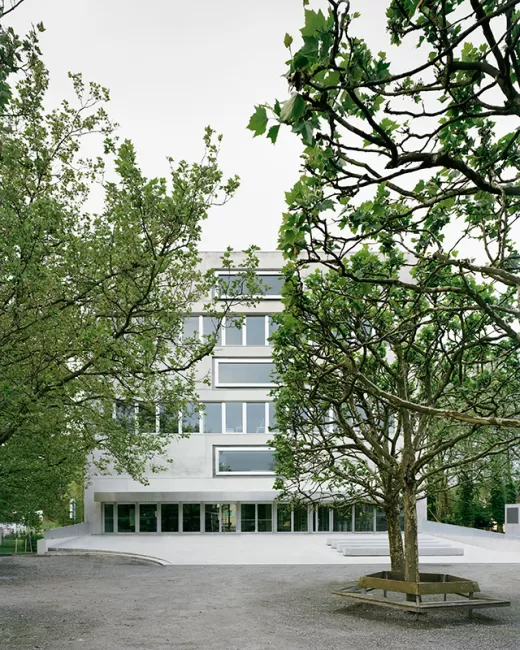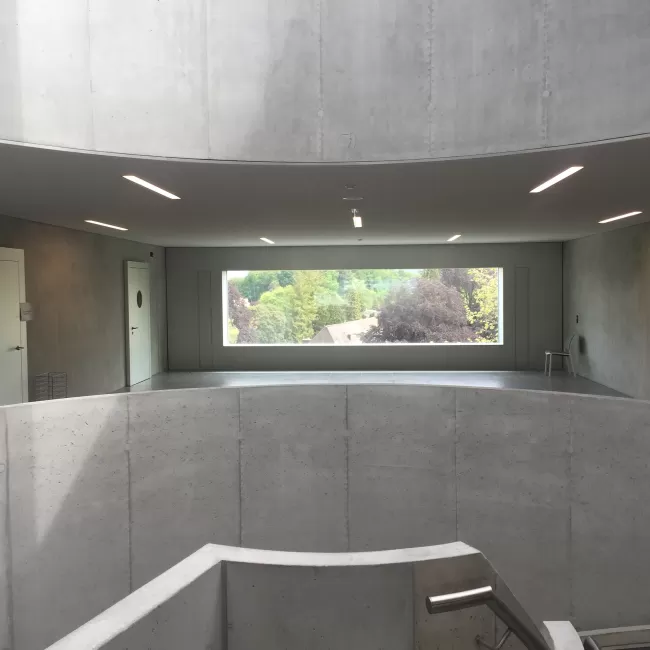Campus Moos

The existing school complex “Im Moos” originates from a 1966 strategic plan by the respected architectural office of Zweifel + Strickler in Zurich. In 1969, however, only two of the three planned structures were built, along with a multi-functional hall and gymnasium wing.
Back then, the complex was focused around a central court, which is still spatially present today. What is notable about the design, beyond the typical modularity of the 1960s building, is the placement of a high point along Säumerstrasse.
Extending an existing site means examining not only the built, but also the unbuilt environment.
This point is of the utmost importance. The existing exterior spaces must be used efficiently, as these spaces are reserves for the future. Because of this reason, we created a punctual, concentrated intervention on the site in order to retain as much open space as possible. The new construction is therefore compact, compressed, and organized vertically. Rather than attempting to engage with the existing building volumes, it serves as a means of directing and determining the outdoor spaces, thus achieving a complete composition between inside and outside.
In order to preserve enough space for the existing sycamores in the forecourt along Säumerstrasse – which forms the entrance to the campus – the new five-story building was placed as far to the southeast as possible. This accentuates the valuable mature plantings while creating well-proportioned, sequential exterior spaces. The green space between the new building, Nidelbad, and the sports fields remains unbuilt and open.

Figure Ground Plan


The architectural expression of the new construction reveals the interior logic of the building on its façade; the floors, inverted at ninety-degree angles, and their generously proportioned or punctual openings characterize its appearance. Thus, a structured building is created with the individual horizontal elements, which sit atop a plinth extending into the landscape.
The robust, simply structured building volume stands almost stoically in the landscape, shaped by trees and open spaces. This approach is replicated in the building’s interior: generous, nearly structure-less spaces allow for flexible uses.
The varied horizontal layers of spaces are based on the same basic program and are primarily structured by two central cores. We have differentiated the ground floor from the floors with craft rooms, the public mezzanine, the teacher’s floor, the classrooms, and the floor with the school kitchens. Stacked upon one another, these layers create the sum of the new building’s program.
While the more public program elements such as the school’s foyer, the multi-purpose hall, and the cafeteria are located in the mezzanine – these spatial units are non-load bearing and can be combined with one another to house large events such as concerts or exhibitions – the first floor contains the rooms for the administration, space for the faculty, and the library.
The floor plan is divided into three zones: the middle zone with its more public functions (principal’s office, administration, social services, and conference room) and two peripheral zones with lounges and offices for the teaching faculty and the library. The middle zone is constructed with full-height, load-bearing walls and, as a “transfer” floor, allows the mezzanine to stand without columns as a maximally flexible space.

Axonometrie Structure

The classrooms occupy the second, third, and fourth floors and are arranged according to the rules established by the first floor. The middle zones serve as recreational spaces with separate educational niches. The classrooms exist on the periphery. Each adjacent classroom can be combined with another neighboring space to form a large learning atelier. Nearby are the group classrooms, which can be accessed both from the individual classrooms as well as from the middle zone. The kitchen is housed on the fith floor, along with the ICT classrooms, the therapy rooms for integrated facilitation, and natural sciences.
All of the upper floors are based on the same spatial principle and are thus can be transferred into school and classroom spaces, such so that the newly created building allows the user maximum flexibility for the future development of education.
In order to create a school with a future, flexibility must be guaranteed. Flexibility means being able to do much and making nothing impossible – without losing a sense of identity.
Such a building requires a structural design that permits many different configurations. A building that defines itself by its flexibility is one that is aware of what can (structural system, infrastructure, and circulation) and what cannot be fixed. Flexibility of use also means allowing exterior spaces to remain free in order to permit possible future development. As such, flexibility must be defined both within and without, in order to ensure that what can be foreseen today remain possible tomorrow.

Section


from left to right: Ground Floor, 1st - 2nd Floor / 3rd - 6th Floor








The robust, simply structured volume stands almost stoically in the landscape, shaped by trees and open spaces. This approach is replicated in the building’s interior: generous, nearly structure-less spaces allow for flexible uses. Flexibility means being able to do much and making nothing impossible – without losing a sense of identity.
Wim Eckert and Piet Eckert
Video:
CAMPUS MOOS - a walk through the new school building
© Alberto Canepa, 2016
Campus Moos
Säumerstrasse
8803 Rüschlikon
Schweiz
Construction Management: Caretta + Weidmann, Zurich
Structural Engineering: Dr. Lüchinger + Meyer Bauingenieure AG, Zurich; Locher Ing., Zurich
Electrical Engineering: R+B Engineering, Zurich
Building Services: Todt+Gmür+ Partner AG, Zurich
Facade Planning: Buri Müller Partner, Burgdorf; Feroplan AG, Zurich
Building Physics: Buri Bauphysik& Akustik, Volketswil
Landscape Architecture: Raderschall Partner Land. Arch., Meilen
Model Photographs: Jon Naiman, Biel